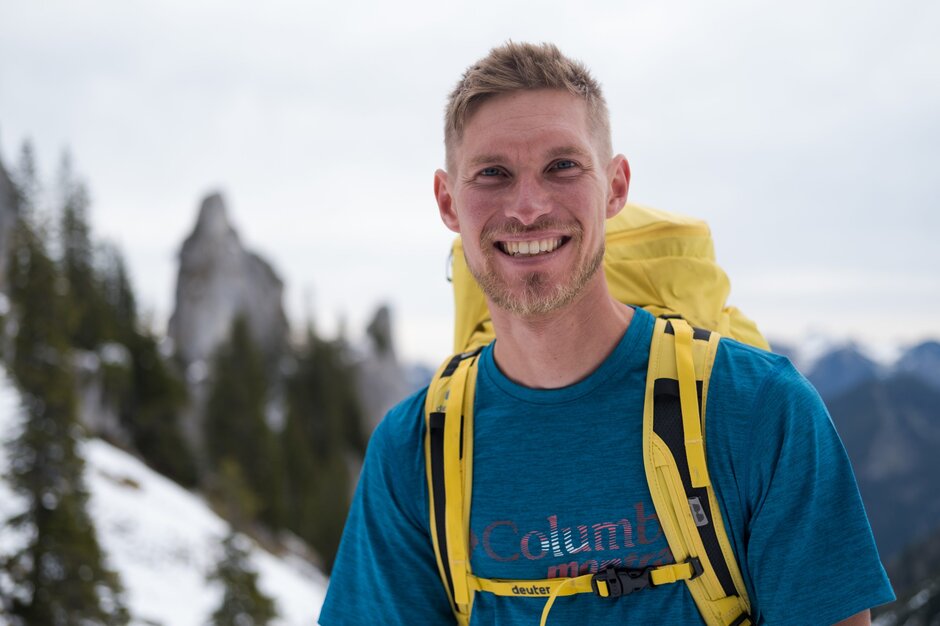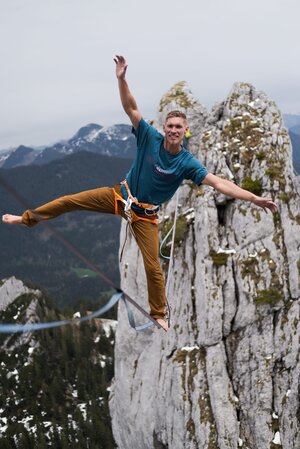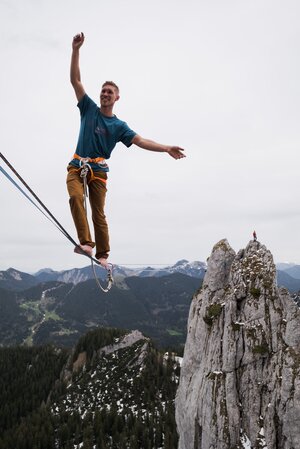Lukas Irmler’s highline on Blankenstein – a dream come true.

Lukas Irmler’s highline on Blankenstein – a dream come true.

Within his grasp
The perfect conditions for world-class slackliner, Lukas Irmler. Always on the hunt for special places to carry out his projects, he discovered Blankenstein and the possibilities it held, while on a reccy with his friends, shortly after moving to Miesbach. It was a dream location. And it soon became clear he’d have to make that dream a reality.
More than a balancing act
Slacklining is much more than a balancing act to inspire awe. Slacklining is the culmination of continuous, rigorous training in a range of sports like trail running, climbing, mountaineering and yoga. But it also involves spending a lot of time on a slackline – up to three hours a day in Lukas’ case – to build up the skills necessary for his increasingly challenging projects. It's the grueling combination of several sports, some of which are very gear intensive.
The Blankenstein slackline site 1,000 vertical meters above the village of Rottach-Egern and 15 km away from it. Covering 700 of the vertical meters by mountain bike cuts down the time it takes to get to the little Röthenstein hut. But it involves backpacks laden with a 70-meter-long slackline, all the highlining equipment, heavy climbing ropes and gear to scale the rock towers of Blankenstein – all of which make biking a bit more challenging than usual. Then there’s grade 4+ climbing – up through grooves, across slabs and ledges up to the summit ridge – followed by the exhausting work of hauling the rest of the gear up to the top.
Work first, play later.
On Blankenstein, even extreme athletes like Munich based Lukas Riediger and Valentin Rapp, and South Tyrolean Aron Bertoli, and even Lukas Irmler himself are reduced to a sweating mess. And they haven’t even started on the most challenging part of the project – the line itself. Because after depositing their bikes at the hut, it’s a steady uphill slog on foot to the Blankenstein saddle, and only then does the actual ascent of Blankenstein begin. While Lukas climbs up the relatively solid rock of the east ridge to their planned anchor point, Lukas Riediger makes his way up the more alpine route on the first of the east towers to rig the other end of the highline. Aron Bertoli first sees Lukas up to the belay station and then hauls all the rest of the gear up in the Wall Bag. Finally, he attaches a thin line to Lukas’ climbing rope and follows Lukas Riediger up the east tower with it. This is how the two towers are linked, and the slackline can be spanned across the gap. And then, it's time to anchor the line. Lukas and his team prefer using what’s known as ‘clean’ methods, by using slings and ropes to wrap around rock formations and leaving no trace. Tensioning a slackline while dangling at 1,700 meters is something that takes many years’ experience, meticulous precision and well-rehearsed teamwork. And patience is also required until everything’s fixed, in the correct place, and the tension is just right. If you’re just walking across a slackline, the tension isn’t too critical – at least not for Lukas – but for the tricks he plans to carry out today, he needs the line to have trampoline-like rebound.

In great height lies great power.
“It’s always a magical moment when the line’s finally rigged,” says Lukas. His gaze is transfixed on the 40-meter line stretching away in front of him, swaying over the abyss. Before starting, he focuses once more, closes his eyes, and goes through the moves in his head one last time. As for which tricks he’s going to perform today, that’s spontaneous. It’s what’s known as Highline Freestyle. Lukas might bounce up and down on the line or push it out from side to side (surfing), to generate momentum for his tricks such as, lying down and bouncing back up again, or flip rotations around the line. Valentin Rapp, highline colleague and talented filmmaker, has his camera trained on Lukas, ready to capture these moments that mean the world to Lukas.
The freedom that gravity provides.
L ukas ties into the leash on the safety rope and slides out onto the thin line. This is the part that really draws him to the mountains and inspires him to defy gravity. The part that lets him forget the hardships of the ascent and all that training. It’s the part he’s addicted to: That sense of freedom he feels on the line. Swaying in the wind up there is an incredible feeling, and bouncing on the slackline, in particular, makes him feel light – weightless even. “In those brief moments, when the line shoots me up into the sky, it’s like gravity ceases to exist. It’s righteous,” Lukas sums up. To us mere mortals, it is an incredible feat. But incorporating some tricks on top of that is virtually inconceivable. “It’s one of the best feelings ever, when you land on the line again after sending a summersault.” It’s certainly something you’d like to believe of the world record holder. Why else would he keep pushing his limits, again and again? Today, on Blankenstein, it’s a Yoda-roll that takes him to the edge – a particularly difficult full rotation around the line. And he stomps it. From concept to goal. Yet another notch on Lukas Irmler’s belt. Another dream come true.
ukas ties into the leash on the safety rope and slides out onto the thin line. This is the part that really draws him to the mountains and inspires him to defy gravity. The part that lets him forget the hardships of the ascent and all that training. It’s the part he’s addicted to: That sense of freedom he feels on the line. Swaying in the wind up there is an incredible feeling, and bouncing on the slackline, in particular, makes him feel light – weightless even. “In those brief moments, when the line shoots me up into the sky, it’s like gravity ceases to exist. It’s righteous,” Lukas sums up. To us mere mortals, it is an incredible feat. But incorporating some tricks on top of that is virtually inconceivable. “It’s one of the best feelings ever, when you land on the line again after sending a summersault.” It’s certainly something you’d like to believe of the world record holder. Why else would he keep pushing his limits, again and again? Today, on Blankenstein, it’s a Yoda-roll that takes him to the edge – a particularly difficult full rotation around the line. And he stomps it. From concept to goal. Yet another notch on Lukas Irmler’s belt. Another dream come true.